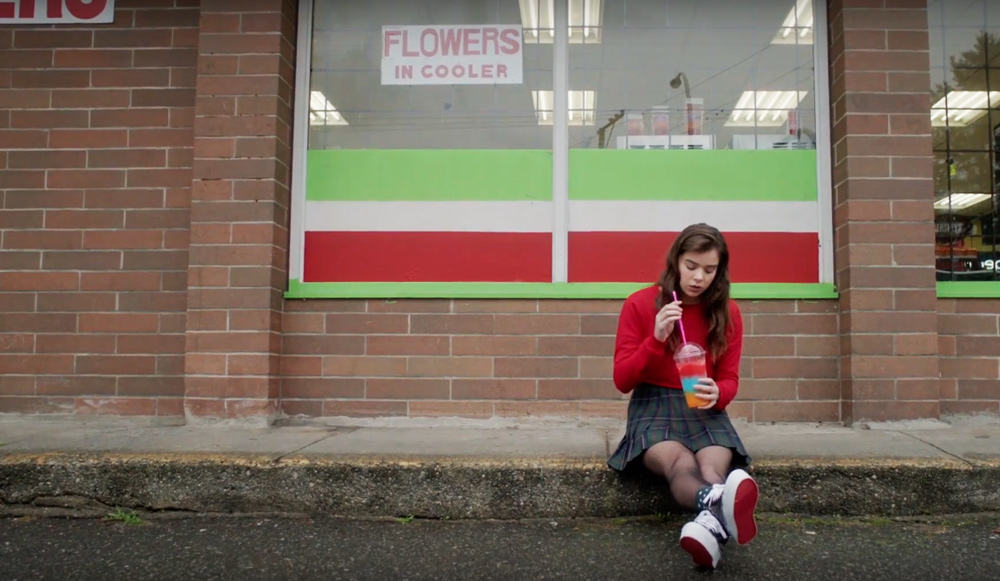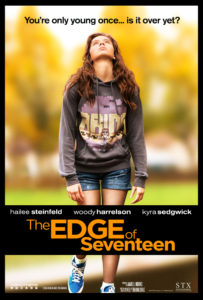
Title: The Edge of Seventeen
Director/Writer: Kelly Fremon Craig
Starring: Hailee Steinfeld, Haley Lu Richardson, Blake Jenner, Woody Harrelson
A review by Thanh Nguyen
 There are some typical, but tried and true tropes that come to mind when we think about the teen film genre: the high school outcast who feels alienated and misunderstood by his/her peers, the dorky but lovable best friend who harbours a secret crush on them, the love interest from the polar opposite social circle, the bully masking some inferiority complex, and of course, the momentous make over which physically transforms the outcast from an “ugly duckling” to a supposed new and improved version of themselves.
There are some typical, but tried and true tropes that come to mind when we think about the teen film genre: the high school outcast who feels alienated and misunderstood by his/her peers, the dorky but lovable best friend who harbours a secret crush on them, the love interest from the polar opposite social circle, the bully masking some inferiority complex, and of course, the momentous make over which physically transforms the outcast from an “ugly duckling” to a supposed new and improved version of themselves.
In some variation or another, we can find these fantasies weaved into a high school narrative about an underdog finding a way to rise to the occasion. The Edge of Seventeen, the directorial debut from Kelly Fremon Craig, while offering a familiar premise about a high school girl going through some major teenage angst, doesn’t feel the need to indulge us with these fantasies. Instead, the film distinguishes itself by eschewing idealism for realism, illustrating a high school experience that is genuine to the ugly and often erratic emotions of adolescence, while being hilarious and heartfelt all at once.
The film’s authenticity is largely credited to a brilliantly written female lead, Nadine, played by the charismatic Hailee Steinfeld. It’s a rarity to see such a fully fleshed out female character whose actions aren’t driven by some need to be with a boy. Rather, it’s a sense of Nadine’s own self-loathing and insecurities, her desperation and loneliness that motivate her to pursue the romantic relations that we see. Already suffering from the death of her father, the cataclysmic event that gradually sends her down an emotional spiral occurs when she wakes up to find her best friend in bed with her own brother. For the majority of the film, she mulls and mopes over their quickly progressing relationship, fearing the loss of the only person she can relate to in her life. Her self-absorbing “woe is me” mentality causes friction within all of her relationships. From her family to her teacher, everyone around her ends up bearing the burden of her misery.
Part of the problem for Nadine is that she is a character who is stuck in the past by still holding onto the pain of losing a parent. A self-proclaimed “old soul”, she also believes that she isn’t able to relate to her smartphone and social media-obsessed generation. Craig cleverly captures Nadine’s vain indulgence for nostalgia through her nod to 80’s films, in particular John Hughes’.
The Edge of Seventeen opens up in an iconic film fashion, tracking a pair of Nadine’s shoes as she struts across her high school campus accompanied by an 80’s-style song. When we see her for the first time, she is wearing a jacket that seems to be inspired by every beloved character with a trademark outerwear from the 80’s, in particular Marty McFly (a character who literally travels back to the past). Wardrobe and music aside, what makes the film so quintessentially Hughes is exploring the divide and disconnect between parent and child. Nadine’s toughest relationship is with her mother. Both struggle to understand each other, and the film gives equally weighted insight to their emotional pain.
Although The Edge of Seventeen is rooted by an emotional core, what gives the film’s edge (yes, cheesy pun intended) is its subversiveness to conventions, boasted by its smart, self-reflexive humour that brings the triteness of teen tropes into light. After a rant to her teacher about her inability to connect with her mindless, technology-dependent peers, he bluntly tells her to consider the possibility that “maybe people just don’t like you”, and advises her to basically get her head out of her ass. In the place of some sage teacher offering words of wisdom, Craig has a mentor who is barely consoling, let alone life changing. It’s as if she is calling attention to every teen character going through “a tough time”, illustrating just how full of themselves they really are. This isn’t to say that Fremont isn’t sympathetic to her main character’s feelings. When others call on Nadine’s BS, it allows her character to understand that she is the root of her own problems, which paves the way for her to resolve her issues on her own terms.
The Verdict
See it! While Hughes might have opened up the dialogue to explore the issues among high school youth, it’s Craig’s patient and more true to life treatment of these issues that elevates the film as something outstandingly its own. With a whip-smart and funny script, spearheaded by a relatable lead character, The Edge of Seventeen has all of the hallmarks of a high school classic in the making and should not be missed.
Edge of Seventeen is currently playing in theatres.

![[REVIEW] THE VARIANTS #1](https://geekd-out.com/wp-content/uploads/2022/06/the-variants-feat-150x150.jpg)
![[REVIEW] ‘SUPERMAN: RED AND BLUE #1’ REMINDS US WHY WE LOVE THE MAN OF STEEL](https://geekd-out.com/wp-content/uploads/2021/03/SupermanFeatured-150x150.jpg)
